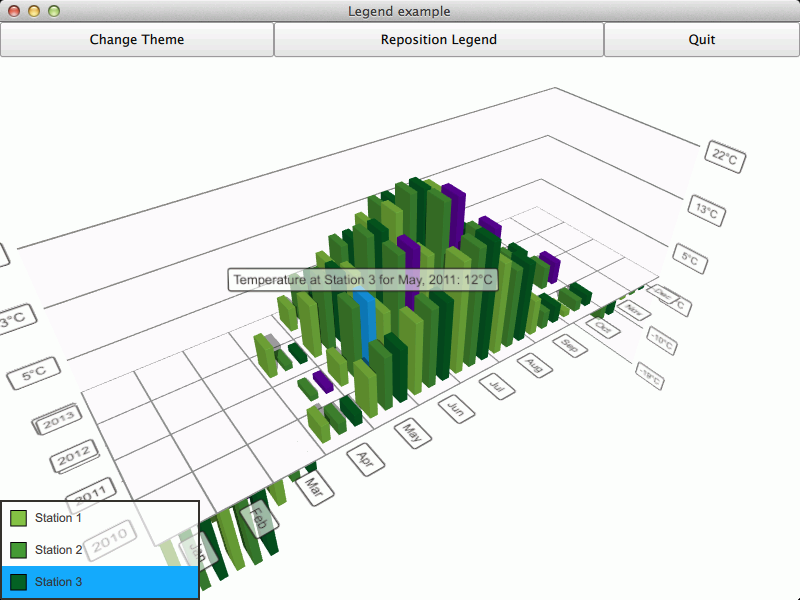Showing graph legend in a QML application.
The Qt Quick 2 legend example shows how to make an interactive legend for a graph.

The interesting thing about this example is displaying the legend. We'll concentrate on that and skip explaining the basic functionality - for more detailed QML example documentation, see Qt Quick 2 Scatter Example .
要运行范例从 Qt Creator ,打开 欢迎 模式,然后选择范例从 范例 。更多信息,拜访 构建和运行范例 .
The legend is simply a column of custom
LegendItem
items inside a transparent rectangle. Each item is supplied with a series and the graph theme:
ColumnLayout { anchors.fill: parent anchors.margins: parent.border.width spacing: 0 clip: true LegendItem { Layout.fillWidth: true Layout.fillHeight: true series: station1 theme: barGraph.theme } LegendItem { Layout.fillWidth: true Layout.fillHeight: true series: station2 theme: barGraph.theme } LegendItem { Layout.fillWidth: true Layout.fillHeight: true series: station3 theme: barGraph.theme } }
The legend items consist of a marker rectangle, which indicates the color of the series, and a text field, which shows the name of the series. The colors we get from the series and the theme supplied at legend item initialization:
property Theme3D theme property Bar3DSeries series ... RowLayout { anchors.fill: parent spacing: 0 clip: true Item { id: markerSpace Layout.minimumWidth: 20 Layout.minimumHeight: 20 Layout.fillWidth: true Layout.fillHeight: true Layout.alignment: Qt.AlignVCenter Rectangle { x: parent.x + parent.width / 4 y: parent.y + parent.height / 4 width: parent.width / 2 height: width border.color: "black" color: series.baseColor } } Item { height: markerSpace.height Layout.fillWidth: true Layout.fillHeight: true Layout.alignment: Qt.AlignVCenter Layout.minimumWidth: 100 Text { anchors.fill: parent text: series.name verticalAlignment: Text.AlignVCenter clip: true color: theme.labelTextColor font: theme.font } } }
We want the legend to be interactive, so we add additional logic to enable selection of a series by clicking on a legend item, as well as highlighting the legend item corresponding to the selected series.
The highlight depends on the selection state of the series, so we define two states, which follow the
Bar3DSeries::selectedBar
property and adjust the
legendItem
color appropriately:
states: [ State { name: "selected" when: series.selectedBar != series.invalidSelectionPosition PropertyChanges { target: legendItem color: series.singleHighlightColor } }, State { name: "unselected" when: series.selectedBar == series.invalidSelectionPosition PropertyChanges { target: legendItem color: theme.labelBackgroundColor } } ]
To make the legend item interactive, we define a MouseArea to detect clicks on it and adjust the series selection accordingly:
MouseArea { id: mouseArea anchors.fill: legendItem onClicked: { if (legendItem.state === "selected") { series.selectedBar = series.invalidSelectionPosition } else { series.selectedBar = previousSelection } } }
The
previousSelection
used above is another custom property of
LegendItem
, which we update whenever selection changes on the series. This way we remember the last selected bar of each series:
Connections { target: series onSelectedBarChanged: { if (position != series.invalidSelectionPosition) { previousSelection = position } } }